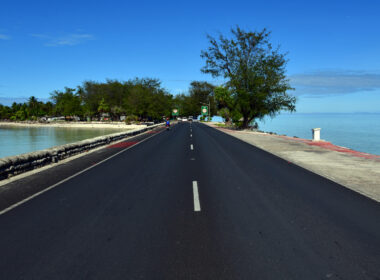Earlier this month, the National Cabinet signed a Heads of Agreement to significantly boost funding for legal assistance services across Australia, with a particular focus on combating gender-based violence.
This unprecedented investment of $3.9 billion over five years marks the most significant injection of funds into the sector in two decades. But is it enough to see any real change? LSJ speaks to Dr Warren Mundy to get his perspective. In March, he completed a major review of the National Legal Assistance Partnership, which was released in May.
The new National Access to Justice Partnership will provide a critical increase of nearly $800 million compared to current funding levels, offering much-needed certainty to hundreds of nationwide services. These include organisations providing essential support to victims and survivors of gender-based violence.
Mundy welcomes this increase but says, it is “very hard to reconcile the government’s numbers” and, in fact, “bordering on impossible”. He says of the $3.9 billion announced, $3.1 billion will be used to extend the current funding base from 1 July 2025, leaving $500 million or $100 million per year of “new” money and $300 million to resourcing pay parity and indexation for workers.
The shortfall
The $100 million per year to be distributed across the legal assistance sector falls well short of the estimates that Fair Agenda has published to address unmet legal needs, which Mundy agrees are reasonable figures.
According to advocacy group Fair Agenda, Women’s Legal Services reports that 1,000 women are being turned away weekly due to insufficient resources. To address this issue, Fair Agenda is calling for an additional $25 million annually for Women’s Legal Services, $60 million for Family Violence Prevention Legal Services (FVPLS), $317 million for Legal Aid Commissions to expand civil and family law grants, and $229 million for Aboriginal & Torres Strait Islander Legal Services (ATSILS).
| Legal assistance provider | Estimated extra funding required per year* |
| Women’s Legal Services | $25 million |
| Family Violence Prevention Services | $60 million |
| Legal Aid Commissions | $317 million |
| The Aboriginal Torres Strait Islander Services | $200 million |
| Total | $602 million |
| Funding | $100 million |
| Difference | $-502 million |
*Estimates taken from Fair Agenda’s estimates to address unmet legal assistance needs.
Mundy adds that the $317 million for Legal Aid Commissions is similar to the $200 million that the Productivity Commission recommended in 2014 when he was the Commissioner, adjusted for the increase in costs and to ensure that everyone who lives below the poverty line can get Legal Aid.
“I find it strange that a number of the legal assistance industry advocates and individual providers are saying, what a wonderful thing this is because it just pulls up short of everything they asked for that they put to me, most of which I actually thought was fair and reasonable,” Mundy says.
It needs to be clarified how that extra $500 million will be distributed now. Still, given it’s in the context of a package relating to violence against women and children, Mundy believes that the majority will likely go towards funding Women’s Legal Services and Family Violence Prevention Legal Services.
While he acknowledges that this should be supported, it leaves little money to deal with general issues around poverty and other forms of entrenched disadvantage. It also doesn’t make provision for the LGBTIQ+ community, veterans, and the desperate need to significantly increase funding for people who experience profound economic disadvantage for whom unmet legal needs have increased over the last five years.
Mundy is waiting to see how the agreement will address the challenges community legal assistance providers – CLCs, ATSILS and FVPLS – continue to face. He points out that community lawyers have caseloads two to four times greater than Legal Aid lawyers but do not get the same support when they work in regional and remote areas, such as government-subsidised housing and transport. Additionally, the limited funding available to the community sector leaves them with inadequate IT systems and workplace support for vicarious trauma.
“They’re not designed for people who, in some cases, particularly the Aboriginal legal services, who have to deal with clients who are often very traumatised and sometimes can be violent,” Mundy says.
“Some of the places in which these people work are just unsafe. Some of them are in inappropriate locations.”
“Fixing their pay rates and annual remuneration is really important, but it doesn’t solve the problem – their workloads and other conditions must be addressed.”
The Heads of Agreement also includes provision of a two-year process to address the issues of Closing the Gap.
Mundy presumes that this will lead to additional funding for legal assistance for Aboriginal Community-Controlled Organisations (ACCOs). However, with the gap widening rather than narrowing, additional funding is needed now, but it isn’t clear how much funding will be provided from the $500 million.
“I am strongly of the view that the greatest urgency for new funding is the indigenous-controlled ATSILs and Family Violence Prevention Legal Services,” Mundy says.
He also points out that the Closing the Gap statement has been around for over a decade, and the current legal assistance funding agreement has been in place for five years. “You sort of wonder why it needs another two years to sort it out?” he questions.
He thinks the real reason is that several jurisdictions don’t believe that funding Aboriginal and Torres Strait Island legal services or Indigenous family violence prevention services is their job, but rather the sole responsibility of the Commonwealth. However, Mundy believes this should be a shared responsibility.
“There’s just not enough clarity around the data to form a view … But if you look at it sort of objectively, there doesn’t seem to be enough money to go around.”
Reducing reliance on short-term, project-based funding
Mundy is pleased to see a range of programs outside NLAP will be rolled into the base funding.
“That’s fantastic, and governments get a tick for that,”
However, he is concerned that new programs may continue to be rolled over without a clear commitment to long-term support. While he understands that governments have legitimate reasons for doing this, he hopes the final agreement reflects his report’s recommendations on ensuring longer-term funding that provides value for money and certainty to service providers.
He suggests governments should be more proactive in scaling up successful programs to other regions that are likely to be effective. This would provide more significant employment security for legal assistance workers and ensure that valuable programs can benefit a wider population.
Mundy also emphasises the need for a more systematic approach to evaluating and scaling programs based on evidence of their effectiveness in specific geographic areas.
“Where we’ve got relatively homogeneous geographies, and if we run a trial in place x, then we should roll it out everywhere, and that looks like place x, and we’ve got to fund that,” Mundy says.
“If a trial works really well in Melbourne, in the outer suburbs of Melbourne…it should be funded to operate in the outer suburbs of Sydney and Brisbane and Adelaide and Perth.”
The impact on private practitioners
In his Independent Review of the National Legal Assistance Partnership (NLAP) report, Mundy focused on the role of private practitioners in delivering legal aid services and highlighted several key areas for reform.
One of the central recommendations is to increase the number of civil legal aid grants. Despite previous calls for this change, the report notes that it has yet to be implemented. By expanding the pool of available grants, more individuals and families in need could access legal assistance.
Additionally, the report urges an increase in legal aid grant rates. The current rates need to be increased to compensate private practitioners for the complexity and time involved in legal aid work. By aligning the rates more closely with court scales, the report aims to encourage more practitioners to take on legal aid cases.
A particularly urgent recommendation is the establishment of a separate funding stream for independent children’s lawyers. These lawyers play a crucial role in family law matters, but their current funding levels are inadequate to reflect their seniority and increased workload. The report seeks to ensure that children’s interests are adequately represented in legal proceedings by providing dedicated funding.
Beyond these specific recommendations, the report highlights several systemic issues within the legal aid system. The current structure of legal aid grants needs to differentiate based on lawyer seniority, which can discourage practitioners from taking on mediation tasks. Moreover, the lack of young lawyers in regional communities poses a significant challenge in providing legal aid services. The report suggests implementing a debt relief scheme to incentivise young lawyers to work in these areas.
Mundy says it’s not clear to him that any of these matters have been addressed yet.
“Now, that’s not to say that they might be addressed the next few months, but it’s not apparent, and there’s no hint of that sort of stuff.”

The future of legal assistance in Australia
While the National Access to Justice Partnership represents a positive step forward in increased Commonwealth funding, it needs to address the fundamental issues plaguing Australia’s legal assistance system, according to Mundy.
“There will be better outcomes for some people. That’s without doubt. But will we significantly reduce the level of unmet legal need? Probably not. It’s one of those things about the difference between material and significant,” he says.
He refers to his report, which outlines a fundamentally different approach to legal assistance funding. Instead of the current system, which relies on arbitrary funding allocations, the report advocates for a method grounded in a thorough assessment of legal needs. This would involve examining demographic and geographic data, as well as the extent to which legal needs are being met without government intervention.
Once this assessment is complete, governments should consider policy actions to reduce or address legal needs. This could involve regulatory changes or other initiatives. The remaining unmet needs would then be addressed by the legal assistance sector.
Mundy also calls for the need of a legal assistance impact assessment, which means when governments change laws, they need to think about the impact on demand for legal assistance services.
He says the Heads of Agreement lacks a commitment from states and territories to provide real increases in legal assistance funding, particularly for Aboriginal legal services. This is despite the fact that these states and territories are enacting laws that directly increase the demand for legal assistance, such as changes to bail laws and the age of criminal responsibility, which have a disproportionate impact on Indigenous people.
These changes increase demand for legal services, particularly in the criminal justice system. Aboriginal legal services, which often have limited resources, are forced to divert their attention from civil matters to handle the increased criminal cases. This can result in negative consequences for Indigenous people, such as more extended periods of detention and coerced guilty pleas.
Mundy says if governments are going to make these changes, “they must fund legal assistance providers in the same way they will the police, the courts, the prosecutors, and the jails because otherwise there is a demonstrable reduction in the Access to Justice, and it will lead to an increase in wrongful convictions, and it will lead to an increase in Indigenous incarceration.”
While the partnership will improve the employment prospects of community legal assistance workers, it fails to achieve parity across all employment terms and conditions with Legal Aid Commissions.
Mundy agrees that the Commonwealth government should play a more active role in funding and managing legal assistance services. There are concerns from within the legal assistance sector that it isn’t appropriate for Legal Aid Commissions to administer the resources of CLCs when they often compete with them in funding processes. While there is a desire for collaboration between Legal Aid Commissions and community based providers, administrative processes often create suspicion and inequality.
He suggests that Legal Aid Commissions may have an advantage due to their size and resources. However, the ultimate success of legal assistance reforms depends on increased funding from state and territory governments. In some smaller jurisdictions such as South Australia, Tasmania and the Northern Territory, the Commonwealth already provides most legal assistance funding, while state governments primarily fund Legal Aid Commissions.
He says the new National Access to Justice Partnership won’t fix it. “It makes it a bit less broken, but it’s only going to really work when the states turn up with money.”
Beyond his review of NLAP, Mundy has played no role in developing this new partnership. However, he emphasises that it should be understood that this agreement is not the only vehicle that governments use to fund legal assistance providers. So far, we only have the Heads of Agreement agreed by the first ministers.
The final details of the National Access to Justice Partnership will be finalised by the end of the year through the Standing Council of Attorneys-General.




